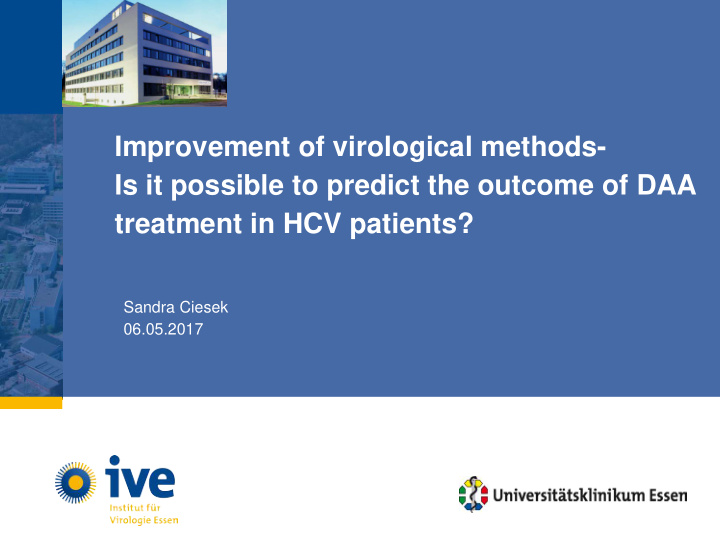



Improvement of virological methods- Is it possible to predict the outcome of DAA treatment in HCV patients? Sandra Ciesek 06.05.2017
Outline - A new in vitro model to predict DAA response? - HCV genotyping – Are all results correct? Folie 2 Titel
Hepatitis C Virus Familie: Flaviviridae Spezies: Hepatitis C virus (7 Genotypen) Genom: (+) ssRNA, ~ 9.6 kb Viruspartikel Replikase Komplex Folie 3 Titel Modifiziert von Pietschmann, Steinmann & Ciesek, DMW 2008
Natural occuring HCV can not infect Huh-7.5 cells in cell culture PHH, Huh-7.5 Human Mouse Chimpanzee Folie 4 Titel
JFH-1 ist the only isolate which forms infectious particles in cell culture JFH-1 RNA chimpanzee Huh-7.5 naïve Huh-7.5 Folie 5 Titel Wakita & Pietschmann, Nat Med 2005; Lindenbach, Science 2005; Zhong, PNAS 2005
Is there a method to predict the outcome af antiviral treatment in HCV? Antibiogram/ Resistogram Natural occurring Huh-7.5 Folie 6 Titel HCV isolates
Sec14L2 allows replication of natural occuring isolates in Huh-7.5 cells M. Saeed et al. Nature 2015 Folie 7 Titel
Not all isolates replicate in Huh-7.5 Sec14L2 cells S e ru m d e riv e d H C V re p lic a tio n in H u h -7 .5 e x p re s s in g S E C 1 4 L 2 E m p ty V e c to r + D M S O S E C 1 4 L 2 + D M S O E m p ty V e c to r + D a c la ta s v ir S E C 1 4 L 2 + D a c la ta s v ir 1 0 5 c o p y n u m b e r/n g to ta l R N A **** 1 0 4 **** **** 1 0 3 H C V R N A 1 0 2 1 0 1 L O D 1 0 0 1 0 -1 1 0 -2 ) ) ) ) ) ) ) ) ) ) ) ) a 3 a a a a a a b b b b 3 ( 3 3 3 1 1 1 1 1 1 1 ( ( ( ( ( ( ( ( ( ( ( 2 0 6 3 2 3 0 1 0 3 5 8 9 6 4 6 7 7 7 7 8 8 8 8 8 4 4 4 4 4 4 4 4 4 4 4 P a tie n t s e ru m s a m p le id e n tifie r (g e n o ty p e ) Folie 8 Titel Costa et al. unpublished
A SNP in Sec14L2 allows replication of all HCV isolates *** *** HCV RNA copy numbers/ ng total RNA *** HCV RNA copies /µl Patient samples Folie 9 Titel Costa et al., unpublished
A model to investigate DAA response before treatment? Patient A.K., • HCV Genotype 3 Infection • OLT in 2009 • 2x DAA therapy (SOF/RBV und SOF/DAC), no SVR • No HCV RASs (at 3 different timepoints) GT3 isolate >300 x Folie 10 Titel
Outlook - In vitro testing of all collected samples and correlation with virological and clinical response - Are there other mutations that lead to resistance ? Folie 11 Titel
Outline - A new in vitro model to predict DAA response? - HCV genotyping – Are all results correct? Folie 12 Titel
Interlaboratory tests of HCV genotyping (Ringversuch) • Ca. 130 labs in Germany have participated (2014/15) Sample Subtype Identification of HCV- Genotype (N) Subtype (N) correct incorrect correct missing incorrect 375021 1b 126 1 110 15 1 375022 5a 125 2 88 37 375023 3a 123 4 89 33 1 375024 1a 126 1 90 14 22 375025 2b 125 2 85 40 375026 5a 125 6 90 35 375027 3a 129 2 99 30 375028 1a 129 2 101 8 20 375029 1b 129 2 122 6 1 375030 4a 128 3 30 98 Folie 13 Titel Quelle: INSTAND e.V.
Which method is the best? Genotype 1a Folie 14 Titel Quelle: INSTAND e.V.
Which method is the best? Genotype 1a Quelle: INSTAND e.V. Folie 15 Titel
Summary • A mutant in Sec14L2 allows replication of all natural occuring isolates • If this model is able to predict the outcome of DAA therapy is currently under investigation • HCV genotyping especially in GT1 patients is –depending on the method that was used sometimes incorrect • Results should be reviewed with a different method in DAA failure Folie 16 Titel
Thank you! AG Ciesek Michael Anspach Tina Bartsch Denisa Bojkova Andreas Clarin Anke Herrmann Nina Kuklinski Antonia Meister Sandra Swoboda Lejla Timmer Verena Wanders Sandra Westhaus Kooperationspartner T. von Hahn, H. Wedemeyer, MHH, Hannover C. Sarrazin, S. Zeuzem, C. Lange, Universität Frankfurt E. Steinmann, T. Pietschmann, Twincore, Hannover R. Kaiser, Universität Köln K. Lang, A. Paul, F. Helfritz, Universitätsklinikum Essen Philip Meuleman, Universität Ghent, Belgien U. Protzer, TU / Helmholtz Zentrum München R. Bartenschlager, Universität Heidelberg Institut für Molekularbiologie Folie 17 Titel A. von Brunn, LMU München und Klinik für Gastroenterologie, Hepatologie und Endokrinologie E. Dazert, Universität Basel, Schweiz
Recommend
More recommend